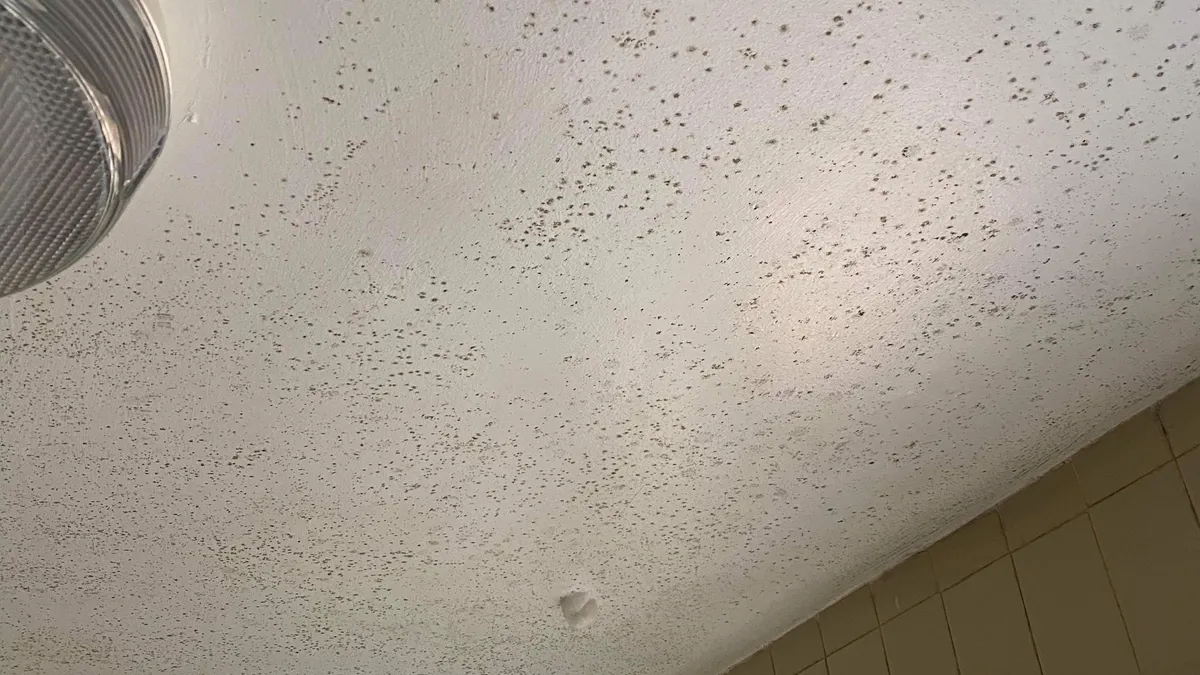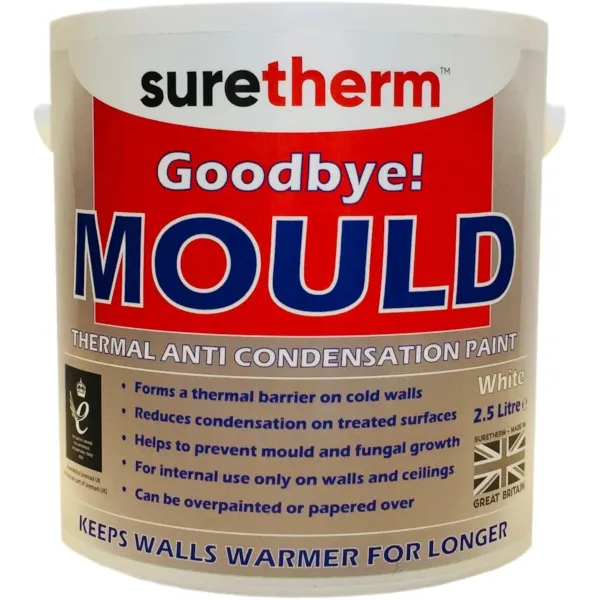The Best Anti Mould Paint
Preventing mould from growing on walls can be a real pain for many homeowners. That is why in the guide we are going to discuss what the best anti mould paint on the market is and how exactly to go about preventing mould growth on your walls.

What Causes Mould On Walls?
The first thing to establish when discussing anti mould paint is what causes mould on walls in the first place? Mould growth is caused by moisture, either from an internal or an external source. External sources of moisture include penetrating damp & rising damp, which can be difficult to diagnose due to the number of potential causes. These include leaking drain pipes, damaged brickwork or particularly porous exterior walls that are absorbing wind-driven rain. There are a number of ways to identify whether the source of mould is external, such as damaged and blistered plaster, rotting skirting boards or wet damp patches that move up from the ground.
The other potential cause of mould is internal condensation. As an internal source of moisture, the best way to help prevent condensation is to improve the ventilation of your house. Avoiding overusing tumble dryers, using extractor fans and opening windows in order to maintain a regular airflow are all ways you can prevent a build up of condensation. Nevertheless, especially in winter, mould can always find a way to develop if you fail to ventilate your home. If the mould is growing in bathrooms, kitchens or other cold walls, this is an indication that condensation is causing the high-moisture environment that allows mould to thrive in.
If you do not regulate the amount of condensation, this mould will continue to grow until it has stained large areas of your walls & ceilings.
Anti Mould Paint
While ensuring good ventilation should be the first port of call when preventing mould, this can be difficult for many homeowners. If this is the case, using an anti-mould paint may be your best option for combating the mould problem. Anti-mould paints are specially designed to prevent mould from growing on your interior walls. They achieve this in a number of ways, with some anti mould paints containing biocides that kill mould growth, while other paints contain advanced technology that prevents the moisture that leads to mould from gathering.
The Best Anti Mould Paint
The chances are, you are looking for an effective mould preventing solution that will do the job long-term. For this reason, we highly recommend Suretherm Anti-Condensation Paint. Suretherm helps prevent the route cause of the problem - the moisture!
Suretherm Anti Condensation Paint is an internal water-based emulsion that is specifically designed to help deal with internal mould and damp caused by condensation. It significantly reduces condensation by absorbing any heat that would ordinarily escape through the wall, thanks to its glass microsphere technology. These glass microspheres become charged like a battery by any heat that passes through them. This heat is absorbed and retained in the coating, which works to evaporate any condensation that attempts to form on the treated surface.
By keeping the interior wall or ceiling warmer, condensation is significantly reduced and any black mould that may have previously bloomed does not have the moisture-rich conditions it requires.
One of the many reasons why we consider Suretherm to be the best anti mould paint available is that it does not contain the harmful biocides that other anti mould paints contain. The advanced heat retaining is what prevents the conditions that allow mould to grow, rather than killing the mould when it grows.
Although Suretherm comes in white as standard, it can be wallpapered over or painted over using any emulsion paint, which makes it ideal as a mould preventing solution to be applied before you decorate. Having said that, if you are looking for a white emulsion, you can use it as your topcoat as well.
Key Features:
- Glass microspheres within Suretherm help to maintain surface temperatures on treated substrates by absorbing heat
- Independently tested
- Condensation takes 57% longer to form when compared to ordinary emulsion paint
- Retains heat over twice as long as ordinary emulsion paint
- Does not contain harmful biocides like other anti-damp paints
- Can be wallpapered over or painted over using any decorative emulsion paint
Alternative Option
Another great option if you are looking for an anti mould paint comes from Zinsser, with their Zinsser Perma-White Mould Resistant Paint. Zinsser Perma-White is a mould resistant, scrubbable interior paint that has contains a biocide that protects the dried coating against fungal degradation.
The paint comes with a lifetime durability guarantee thanks to it's scuff & scrub resistance, as well as it being self-priming and fade resistant.
Key Features:
- Mould resistant
- Scrubbable
- Contains a biocide that protects the dried coating against fungal degradation
- Designed to resist cracking, peeling and blistering for up to 7 years before first maintenance
How To Apply Anti Mould Paint
The process of applying your anti mould paint will vary depending on which paint you opt for, however there are a number of common steps.
What you will need:
- Paint
- Masking tape
- Dust sheet
- Mould killing cleaner
- Cloth
- Paint brush
- Medium-pile roller
- Paint tray or kettle
- Filler (if required)
Step 1: Preparation
The single most important step of any painting project is to prepare the surface before painting, as any professional decorator will tell you. This can make or break your project, so make sure you take your time and don't skip steps.
All surfaces must be clean, dry and free from anything that can interfere with the adhesion of the paint. Remove loose and failing paint from the wall if required by scraping or brushing with a stiff bristle brush to a sound edge.
Remove all visible mould before painting using a suitable cleaning solution such as Zinsser Mould Killer. This should be done by firstly wiping the surface down using hot soapy water to remove the initial layer of mould, followed by spraying the cleaning solution on to the surface and allowing it to dry. This does not need to be removed before painting.
Fill any cracks and small surface defects on the wall with a suitable filler & allow to dry, before sanding down to leave a smooth finish.
Finally, apply masking tape to any edges and protect the floor using a dust sheet to prevent any paint splatter on your carpet.
Step 2: Painting
Now the important part, the painting. Start with your first coat of paint, firstly painting around the edges of the wall or ceiling using your paint brush. Once this is done, you can then use a medium-pile roller to paint the rest of the surface.
Once you have applied you first coat of paint, leave to completely dry. With a water-based emulsion, you will need to wait up to 4 hours between coats, however check the manufacturer's instructions for the paint you are using.
Once dry, it is time to apply a second coat. Apply the second coat, again starting with the edges and finishing with a roller to paint the rest of the surface. Allow to completely dry. If you are using Zinsser Perma-White, this is your finishing coat so ensure you achieve your desired finish. If you are using Suretherm, once completely dry you can apply two coats an emulsion paint of your choice to the treated surface.
Frequently Asked Questions
Q. Does stain block paint stop mould?
Stain blockers will allow moisture to escape, which will help prevent the regrowth of mould, although it will not solve the source of the moisture. If you want to prevent mould, you must first attend to this.
Q. Can you paint straight over mould?
Painting directly over mould is not a good idea. You must remove the mould before painting, as it will simply grow back again. First deal with the source of the water, then clean off the mould, only then can you paint or prime over the area using an stain blocker.
Q. Is anti mould paint safe?
Yes, anti mould paint is completely safe for internal use. While some anti mould paints contain biocides, once dry these are not harmful.
Q. What colours does anti mould paint come in
Both Suretherm Anti Condensation Paint and Zinsser Mould Resistant Paint come in white as standard.
Zinsser Mould Resistant Paint and a number of other paints that we have in stock can be mixed in a huge range of colours if you desire a 2 in 1 solution. This includes Zinsser, British Standard & RAL shades, as well as equivalent shades of other paint manufacturer's including designer shades. If you know the name of the shade, that is all we need to be able to mix it in that colour. Simply type in the name of the shade in the text box or select a colour of choice from our colour charts.
If you would like to shop our full range of paints that we can mix in any colour, visit out paint mixing page.
We hope this has answered any questions you may have had regarding the best anti mould paints & how to apply them. Our team of experts are on hand to assist you with any questions you may have. Simply send an email to hello@paintersworld.co.uk or send us a message on social media. At Painters World we have a wide range of paints available, so no matter the job, we've got the right tools for you. Plus, get FREE next working day delivery on all orders over £50!



Sign up now and be the first to know about exclusive offers, product updates, and announcements.


